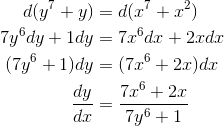We can differentiate any function that is written as a formula, and find a result in terms of a formula. However, sometimes the original problem can’t be written in any nice way as a formula. For example, suppose we want to find dy/ dx in a case where the relationship be- tween x and y is given by the following equation:

There is no equivalent of the quadratic formula for seventh- order polynomials, so we have no way to solve for one variable in terms of the other in order to differentiate it. However, we can
still find  in terms of
in terms of  and
and  . Suppose we let
. Suppose we let  grow to
grow to  . Then for example the
. Then for example the  term will grow to
term will grow to  . The squared infinitesimal is negligible, so the increase in
. The squared infinitesimal is negligible, so the increase in  was re-
ally just
was re-
ally just  , and we’ve really just computed the derivative of
, and we’ve really just computed the derivative of
 with respect to
with respect to  and
multiplied it by
and
multiplied it by  . In symbols,
. In symbols,

That is, the change in  is
is  times the change in
times the change in  . Doing
this to both sides of the original equation, we have
. Doing
this to both sides of the original equation, we have

This still doesn’t give us a formula for the derivative in terms of  alone, but it’s not entirely use- less. For instance, if we’re given a
numerical value of
alone, but it’s not entirely use- less. For instance, if we’re given a
numerical value of  , we can al- ways use Newton’s method to find
, we can al- ways use Newton’s method to find  , and then evaluate the derivative.
, and then evaluate the derivative.
- 2741 reads






